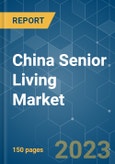The Chinese senior living market is expected to record a CAGR of over 12% during the forecast period.
The COVID-19 outbreak had a significant negative impact on the senior living market, with widespread outbreaks reported in the senior communities across the country, affecting residents, staff, and visitors. Long-term care facility residents became vulnerable due to their age and various underlying diseases. Smaller providers are severely impacted, as they may not be able to cover the additional costs imposed by COVID-19. Some providers are expected to close due to this, which may have a negative impact on some local communities.
China's population of 60 and above is 18%, which is higher than the 10% benchmark that defines an aging society. However, though China's population ages, its wealth is growing, resulting in the expansion of upscale senior communities across the country.
Senior communities provide a great opportunity for insurance companies as these communities require insurance capital. An insurance company has large, stable, and long-term capital, ideal for establishing and running such a community. By 2021, Taikang Insurance opened seven senior communities. It plans to open another 22 senior communities soon. Many major insurance companies also entered the retirement community market. So far, 10 insurance companies have invested in 47 senior communities across the country, providing 84,000 beds.
Apart from insurance companies, large property groups are also interested in developing senior communities. Yuecheng Group, which previously invested in trade and property, shifted its focus toward this industry with its senior community project, Golden Home.
China Senior Living Market Analysis Trends
Increase in Senior Population and Life Expectancy
According to the data released by China's National Bureau of Statistics in January 2022, the Chinese population was estimated at around 1.412 billion in 2021. In 2026, the population is estimated to reach 1.43 billion.
The median age of China’s population was around 38.5 years in 2020. Although China's population median age is still lower than that of many developed countries, such as Japan, the consequences of a rapidly aging population have already become a source of concern for the country's future. China's large labor force contributed to the country's phenomenal economic growth in recent decades. However, the country’s aging population will soon become a burden on its social welfare system, potentially altering its economic situation.
In 2021, women in China had an average life expectancy of 79.24 years, and men had an average life expectancy of 74.76 years.
As in many other countries, increased life expectancy in China is seen as the primary cause of an aging population. China's life expectancy increased due to improved healthcare and living standards. The country’s one-child policy resulted in a lower fertility rate, thus increasing the percentage of older people.
From 1950 to 2020, the average life expectancy increased from 44.6 years to 77.47 years, and it is expected to reach around 80 years in 2050. The percentage of older people in rural areas is slightly higher than in urban areas. Western China has a rapidly aging population.
Integrated Aged Care and Medical Services Boosting the Sector
In China, the demand for healthy old-age care is rapidly increasing. The traditional old-age care model can no longer meet the medical and long-term care needs of elderly patients. A multi-faceted solution is required to promote the development of medically integrated old-age care.
Over the last decade, China's central government has issued a series of policies to encourage the development of aftercare facilities, specify approaches to integrating health and care service delivery at the institutional and community levels, examine long-term care insurance (LTCI) as a funding mechanism, and reform administrative structures to promote integration.
In 2020, China's two basic public pension insurance systems covered approximately 999 million people. Around 456 million were covered by public pension insurance for urban employees, while the rest were covered by public insurance for urban-rural residents.
In February 2022, toward implementing a national strategy to address population aging, China's State Council released a plan to develop the country's elderly care services system during the 14th Five-Year Plan (2021-2025). The plan lays out major objectives and tasks for the next five years, including increasing the availability of elderly care services, improving the health support system for the elderly, and advancing the development of innovative and integrated service models.
China also intends to build about 10 industrial parks dedicated to the silver economy and a string of cities that will serve as models in this regard. According to the officials, the facilities for elderly care will be prioritized in the construction layout.
From 2022, at least 55% of the funds raised through the country's welfare lottery will be used to support elderly care services, and elderly care institutions are encouraged to explore additional financing options.
China Senior Living Market Analysis Competitive Analysis
The market is fragmented with the presence of many local real estate and insurance companies, such as Vanke, Sino-Ocean Group, and Taiking Life. Many major insurance companies are entering the market. Large property groups are also interested in developing senior communities. Several international players are entering the market to invest in and develop more senior communities across the country.
Additional Benefits:
- The market estimate (ME) sheet in Excel format
- 3 months of analyst support
This product will be delivered within 2 business days.
Table of Contents
Companies Mentioned (Partial List)
A selection of companies mentioned in this report includes, but is not limited to:
- China Vanke
- Sino-Ocean Group
- Taikang Life
- Cherish-Yearn
- Poly Property
- New China Life
- China Taiping
- Lendlease
- Aveo
- Wuxi Langgao Elderly Service*
Methodology

LOADING...










